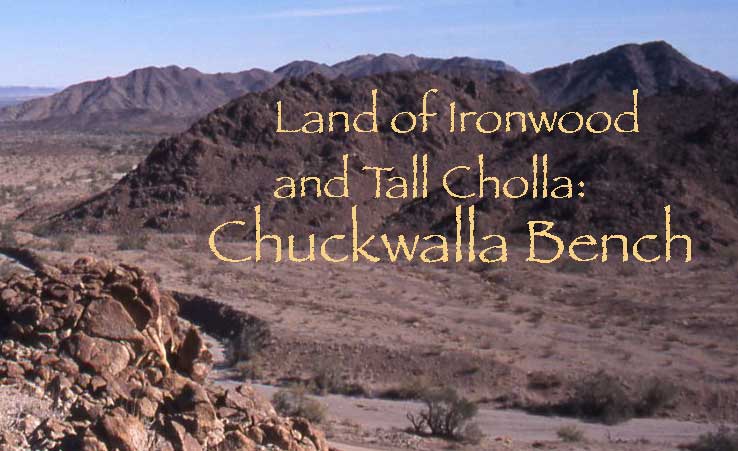Exploring the Chuckwalla Valley Area
page 1, 2, 3, 4
By LMC , August 2009
In May and again in December 1999 Basin and Range Watch members undertook expeditions to the Chuckwalla Bench in search of the secretive Burro deer, a desert-adapted type of Mule deer, and on the way wondered at the tree-like Munz cholla and colorful wash thickets of Ironwood and Palo verde.

^Dry-season Munz cholla on Chuckwalla Bench.
The area lies east of Palm Springs out in the remote Colorado Desert of Riverside County, a subsection of the Sonoran Desert. Chuckwalla Bench is a great dissected bajada (coalesced fans of sediment eroded from nearby mountains) flowing almost without slope away from the Chuckwalla Mountains to the southern horizon. Sparse creosote and bursage with Mojave yucca grew on flats and low mesas, interspersed with arid desert pavement
Characteristic of the area are great wide sand washes filling the valley bottoms, grown with diverse thickets of low desert woodland. Here we looked for the Burro deer among the shady Ironwood trees (Olneya tesota), Palo verdes (Cercidium floridum), Honey mesquites (Prosopis glandulosa var. torreyana), Desert willows (Chilopsis linearis), Smoke trees (Psorothamnus spinosus) and Graythorn (Zizyphus obtusifolia var. canescens). Many were in flower in May: bright yellows of the palo verdes and mesquites, pinks of the Desert willows, and pale purples of the Ironwoods.
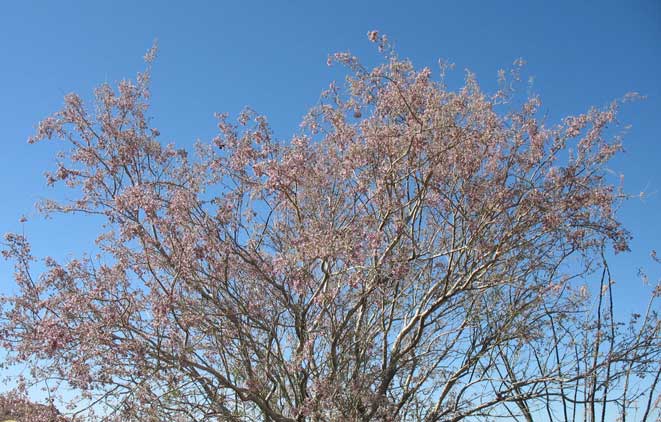
^Ironwood in bloom.
Desert Ironwoods can grow to 35 feet tall and after warm-season rains are covered with purple pea-flowers, revealing its family relationship. So-named because the wood of this tree is extremely dense and hard - it reportedly sinks in water. Native people made arrowheads from the rock-like wood.
(Below left) Wilson's warbler migrant in Palo verde. (Right) Ironwood flower.

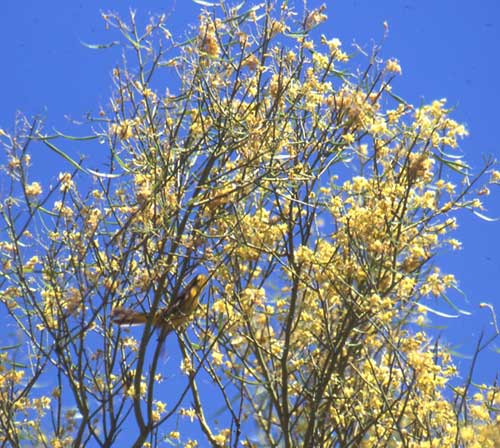
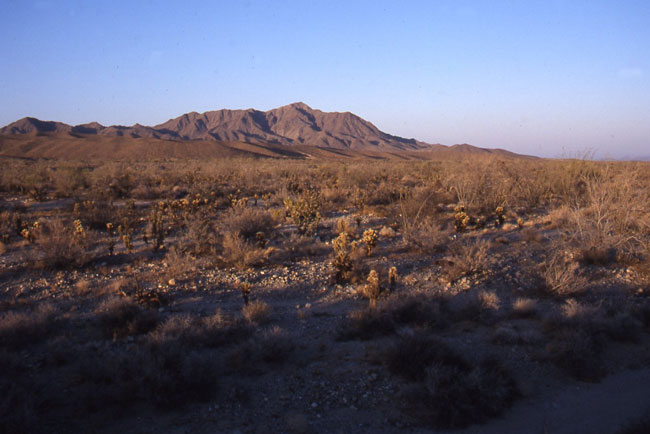
^Chuckwalla Bench in winter with the Chuckwalla Mountains in the distance.
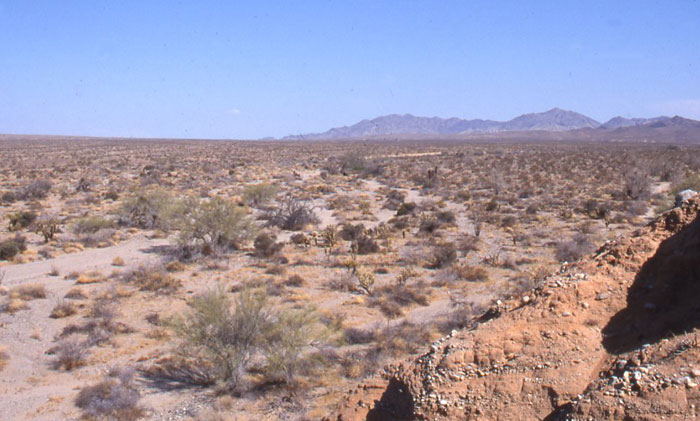
^Broad wooded washes at Chuckwalla Bench.
We found tracks of a Burro deer under a thicket, but never saw the animals themselves. Yet the trip was full of life. Large Graythorn trees in a wash were already full of berries, attracting a giant flock of Phainopeplas: shiny black males and gray-feathered females, dozens in one tree feeding on the fruits.
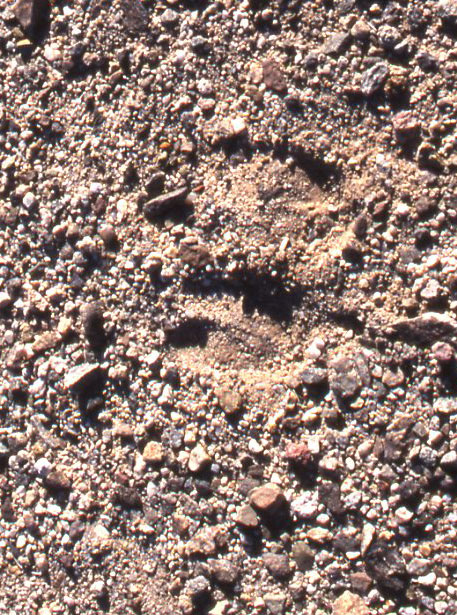
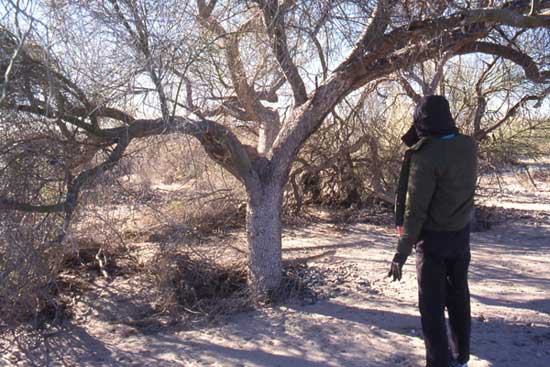
^Ironwood thicket in cold and windy December where Burro deer tracks found.
>Burro deer tracks. We also found the tracks of coyotes, kit foxes, jackrabbits, and kangaroo rats.
The desert is patchy, we noticed: this lush Graythorn area was only in one area, and the surrounding desert was bone-dry from a winter drought. Rains will often fall in a square mile or less, then move on.
In other parts, the Phainopeplas fed on mistletoe berries, spreading their seeds in their scat which they deposited onto branches of new host trees. The mistletoe plant is a parasite on trees, mostly Ironwoods here, and the birds allow the mistletoe to gain a foothold on widely scattered trees and shrubs.
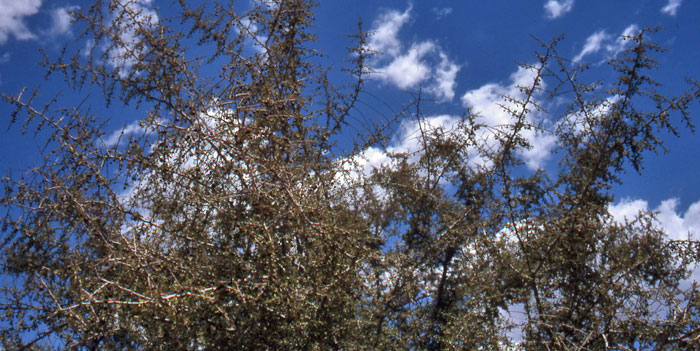
^Graythorn.
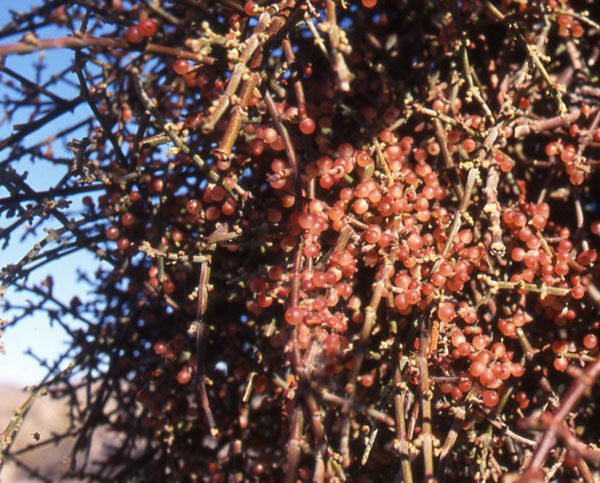
^Mistletoe berries.
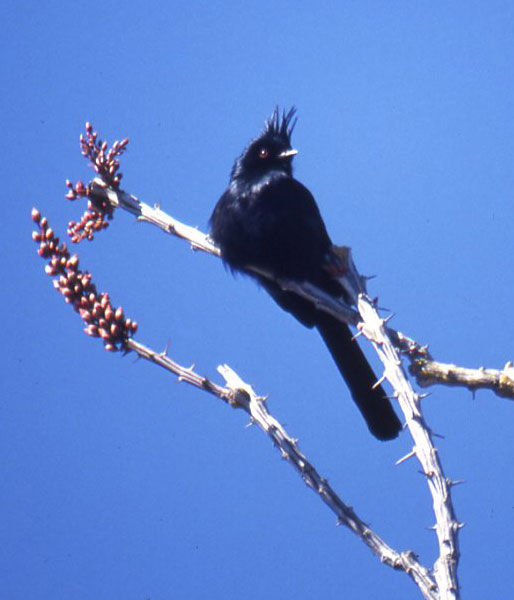
^Male Phainopepla on Ocotillo.
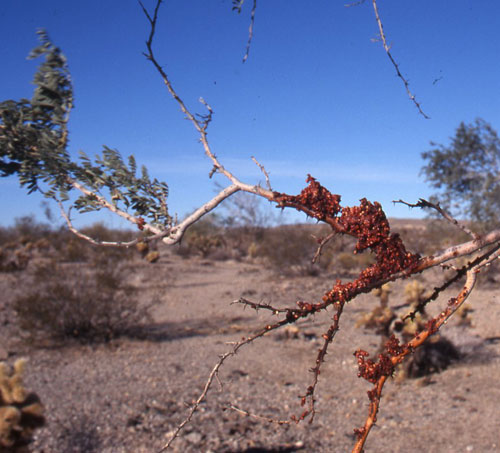
^Bird droppings full of mistletoe seeds.
Birds were very common with the flowering wash trees and buzzing insects. Spring migrants were moving through, including a rarity: a Hooded warbler male hopping in a flowering Palo verde, staying near the ground in low twigs (see sketch). Wilson's warblers, Western tanagers, Yellow warblers, Warbling vireos, and a single Yellow-breasted chat also moved about in the thickets.
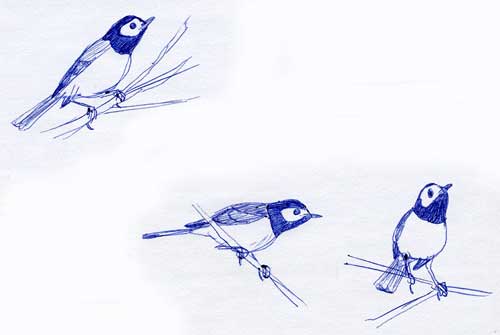
Sketch of the Hooded warbler seen at Chuckwalla Bench, May 22, 1999.
Residents were also evident: Gambel's quail in the washes, kingbirds calling from an Ironwood. A Prairie falcon caught a young rabbit and flew off with it in its bill. At sunset Lesser nighthawk males with white throats chased after females in the air, uttering Kookaburra-like cackles.
- Prairie falcon
- Red-tailed hawk
- Turkey vulture
- Gambel's quail
- Greater roadrunner
- Lesser nighthawk
- Costa's hummingbird
- Mourning dove
- Ladder-backed woodpecker
- Western kingbird
- Ash-throated flycatcher
- Common raven
- Cactus wren
- Verdin
- Black-tailed gnatcatcher
- Northern mockingbird
- Horned lark
- Mountain bluebird
- Western tanager
- Loggerhead shrike
- Warbling vireo
- Yellow warbler
- Wilson's warbler
- Yellow-breasted chat
- Hooded warbler
- Black-throated sparrow
- House finch
Birds seen at Chuckwalla Bench:

^Black-tailed gnatcatcher on nest in Palo verde.
Although we saw the Bench during a drought, the weather still provided some excitement. From my field notebook, May 22, 1999:
"That night at our camp on a desert pavement terrace next to a wash, the night was mostly clear. A quarter Moon, Venus (bright), and Mars ran along the ecliptic, almost perpendicular to the Milky Way. A few silvery cirrus streaks glowed in the moonlight.
 "At 2:00 am I felt a few drops of rain on my face: I awoke to find a storm cell had moved in from the south, trailing dark streamers of rain towards the Colorado River, and obscuring the Moon. Starry night sky still occupied the west. This soon developed into a full-fledged monsoonal thunderstorm, and we found ourselves in the midst of it. We threw our gear into the truck and drove off as lightning hit all around with lion-roars of thunder. At times, the whole desert flat was eerily lit up white, showing ghostly spines of ocotillo. Rain grew to a downpour. Lightning, at times horizontal, broke out in branches across he belly of the cloud.
"At 2:00 am I felt a few drops of rain on my face: I awoke to find a storm cell had moved in from the south, trailing dark streamers of rain towards the Colorado River, and obscuring the Moon. Starry night sky still occupied the west. This soon developed into a full-fledged monsoonal thunderstorm, and we found ourselves in the midst of it. We threw our gear into the truck and drove off as lightning hit all around with lion-roars of thunder. At times, the whole desert flat was eerily lit up white, showing ghostly spines of ocotillo. Rain grew to a downpour. Lightning, at times horizontal, broke out in branches across he belly of the cloud.
" At 3:30 am the cell moved to the north, beyond the Chuckwalla Mountains, leaving us to make a new camp. Lingering thunder bounced off distant mountains and cloud. Lightning silhouetted the range. Trailing cloud tails overhead soon passed, revealing the starry night again.
"The next morning the small washes were wet from mini-floods."
Thus the desert showed us its changeable ways, sudden and dramatic punctuations to the quiet landscape. We met a Bureau of Land Management ranger the next day who told us rain like that was highly unusual, almost unheard-of, this time of year (spring). But every year, he went on, they get big "gully washers" in August and September.
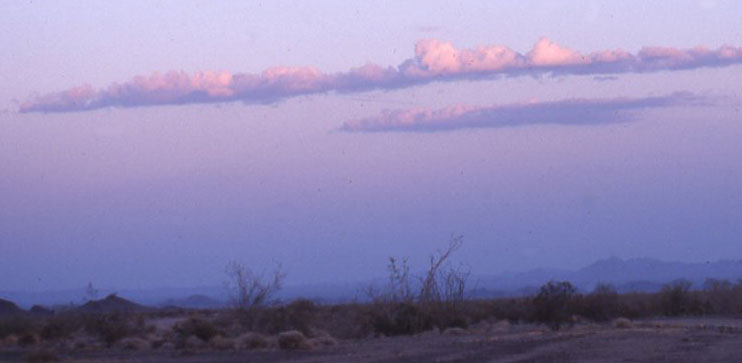
Munz Cholla
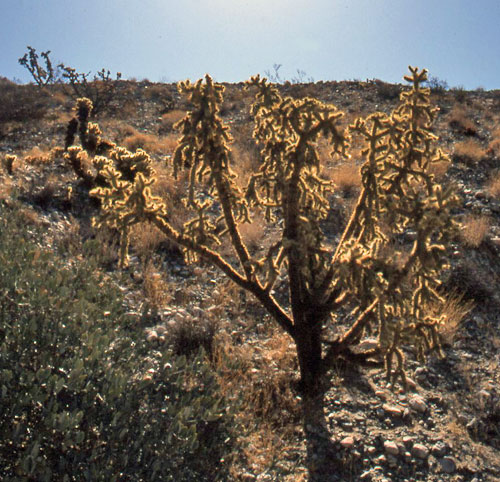
This amazing rare cactus (Cylindropuntia munzii) grows to tree size: 6 or even 10 feet tall, usually with a trunk and broad branching canopy of thorny branches. It occurs on flats and bajadas of the southern Chuckwalla Mountains: the so-called bench, as well as a few populations in the Chocolate Mountains up to 2,300 feet elevation. This is the total U.S. range. Other populations are found in northeastern Baja California south of the border.
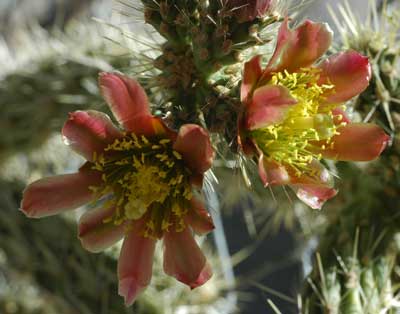 Typical of chollas, a segment branch will break off and fall to the ground, or catch on the leg of a passing deer or person, and sprout roots in a new location. The flowers are small and brownish-orange-yellow, appearing in spring.
Typical of chollas, a segment branch will break off and fall to the ground, or catch on the leg of a passing deer or person, and sprout roots in a new location. The flowers are small and brownish-orange-yellow, appearing in spring.
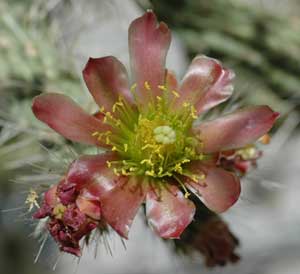
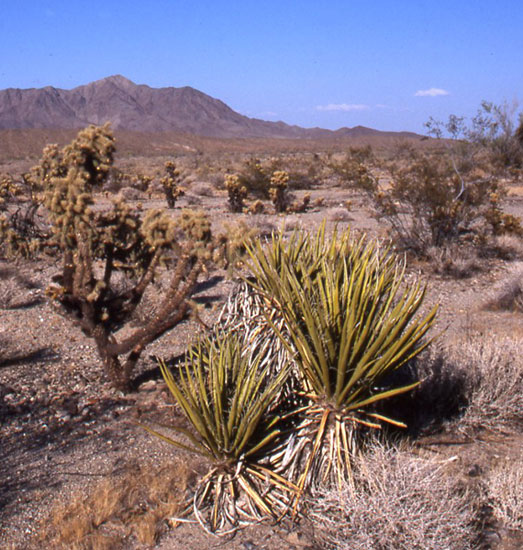
^Munz cholla and Mojave yucca (Yucca schidigera).
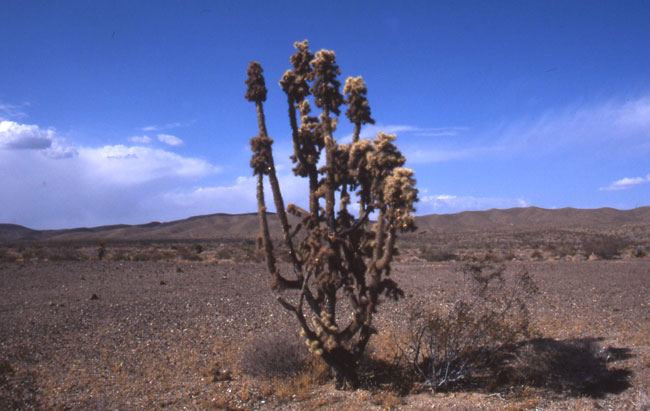
^Desert pavement with scattered Creosote and Munz cholla.
The Elusive Burro Deer
The Burro deer (Odocoileus hemionus eremicus), from a Sonoran word "bura", is a Colorado Desert specialist in an extreme land that does not seem fitting for deer. From the Colorado River they range west into California along vegetated washes to the Coxcomb Mountains, Palen Mountains, Chuckwalla Mountains, Chocolate Mountains, and formerly through the Imperial Valley to Indio. They ranges south into Sonora and Baja Mexico.
The burro deer has a lighter color than other subspecies of Mule deer, a grayish yellow with small pale rump patch, the white tail with a small black tip. It is a large deer, larger than other desert deer, with a heavy dentition to cope with the arid flora on which it lives. Antlers on the bucks are large and wide-branching, identical to Rocky Mountain mule deer (O. h. hemionus).

Sparse populations inhabit vast wash thickets, mesquite bosques (woods), arid mountain foothills, to washes and riparian jungles of the Colorado River. In the dry season they concentrate around springs, tanks, and willow-mesquite thickets along the river. In wetter seasons the deer will move out into the washes with extensive low woodlands of Palo verde, Ironwood, and mesquite. They tend to occupy the lower hills and bajadas below the range of Bighorn sheep.
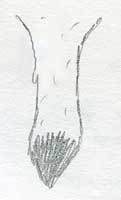 They dine on Honey mesquite leaves and bean pods, green Galleta grass leaves, and the leaves of Palo verde, Ironwood, Catclaw acacia leaves and pods, Jojoba, Rattany, and Ocotillo leaves. In spring they eat wildflowers such as buckwheat, brodiaea, euphorbias, and Apricot mallow. Mistletoe is a favorite, and the deer seek it out all year. They also will take cholla fruits, an important water supplement.
They dine on Honey mesquite leaves and bean pods, green Galleta grass leaves, and the leaves of Palo verde, Ironwood, Catclaw acacia leaves and pods, Jojoba, Rattany, and Ocotillo leaves. In spring they eat wildflowers such as buckwheat, brodiaea, euphorbias, and Apricot mallow. Mistletoe is a favorite, and the deer seek it out all year. They also will take cholla fruits, an important water supplement.
The rut takes place in fall, later than Arizona mule deer. Fawns are dropped in August-September to coincide with the summer monsoon.
They inhabit the lower Colorado River, formerly from the delta north to Headgate Rock Dam. In Arizona they are thinly spread across the southwestern desert of Cabeza Prieta, and will hybridize with the Arizona desert mule deer (O. hemionus crooki).
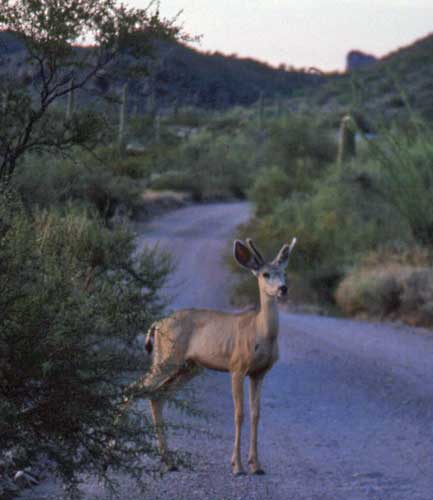
<I photographed this young buck Arizona mule deer at Organ Pipe Cactus National Monument in southern Arizona one year. It is similar to the Burro deer of Chuckwalla Bench.

^Chuckwalla Bench and washes (December).
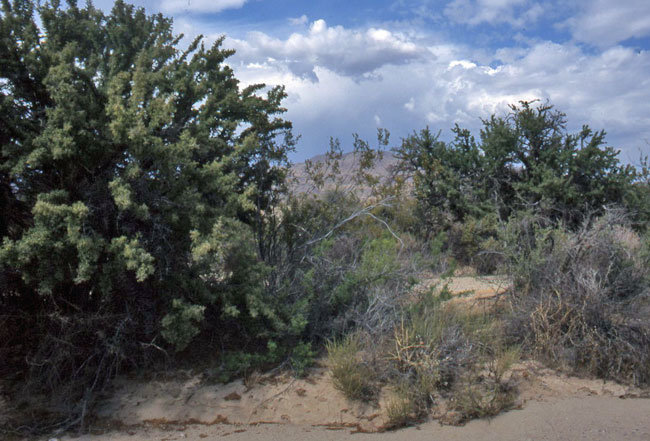
^Lush Graythorn wash thickets in May.
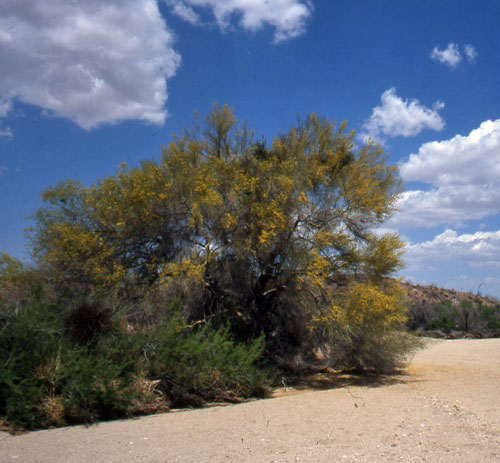
^Flowering Palo verde.
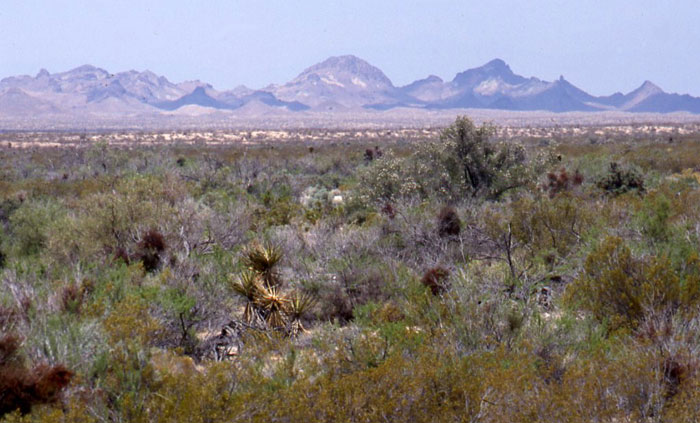
^Vast Sonoran vegetation woodlands at Chuckwalla bench.
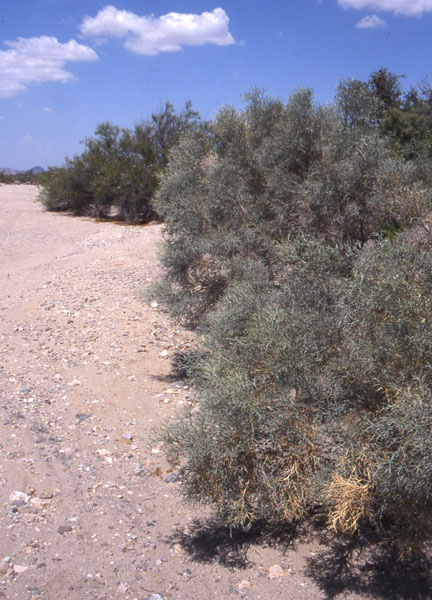
^Smoke trees.
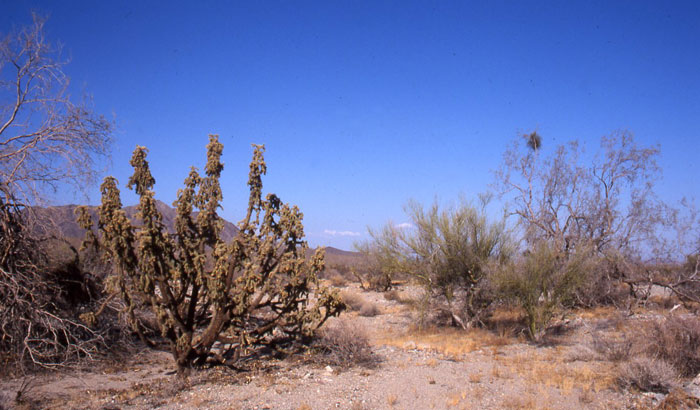
^Munz cholla, Palo verde, and Ironwood.
(Below) Chuckwalla Mountains.
Chuckwalla Bench Plant List:
- Creosote (Larrea tridentata)
- Bursage (Ambrosia dumosa)
- Cheesebush (Hymenoclea salsola)
- Four-wing saltbush
- (Atriplex canescens)
- Mormon tea (Ephedra sp.)
- Jojoba (Simmondsia chinesis)
- Rattany (Krameria spp.)
- Catclaw acacia (Acacia greggii)
- Blue palo verde (Cercidium floridum)
- Ironwood (Olneya tesota)
- Honey mesquite (Prosopis glandulosa var. torreyana)
- Desert willows (Chilopsis linearis)
- Smoke trees (Psorothamnus spinosus)
- Graythorn (Zizyphus obtusifolia var. canescens)
- Waterweed (Baccharis sergiloides)
- Virgin bower (Clematis ligusticifolia)
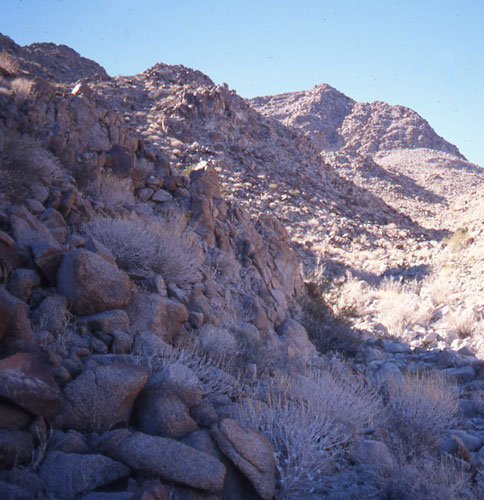
- Desert milkweed (Asclepias subulata)
- Brittlebush (Encelia farinosa)
- Bush encelia (Encelia frutescens)
- Pygmy cedar (Peucephyllum schottii)
- Matchweed (Gutierrezia sarothrae)
- Paperbag bush (Salazaria mexicana)
- Spiny senna (Senna armata)
- Ocotillo (Fouquieria splendens)
- Desert lavender (Hyptis emoryi)
- Bladderpod (Isomeris arborea)
- Wolfberry (Lycium spp.)
- Spiny-herb (Chorizanthe rigida)
- Munz cholla (Cylindropuntia munzii)
- Pencil cholla (Cylindropuntia ramosissima)
- Teddybear cholla (Cylindropuntia bigelovii)
- Mojave mound cactus (Echinocereus triglochidiatus)
- Barrel cactus (Ferocactus cylindraceus)
- Desert mistletoe (Phoradendron californicum)
- Big galleta grass (Hilaria rigida)
- Fluffgrass (Erioneuron pulchellum)
- Six weeks grama (Bouteloua barbata)
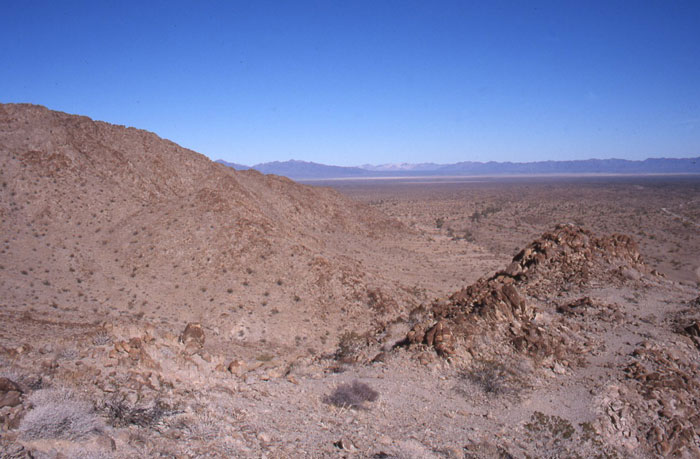
^View of Chuckwalla Valley from the slopes of the Chuckwalla Mountains.
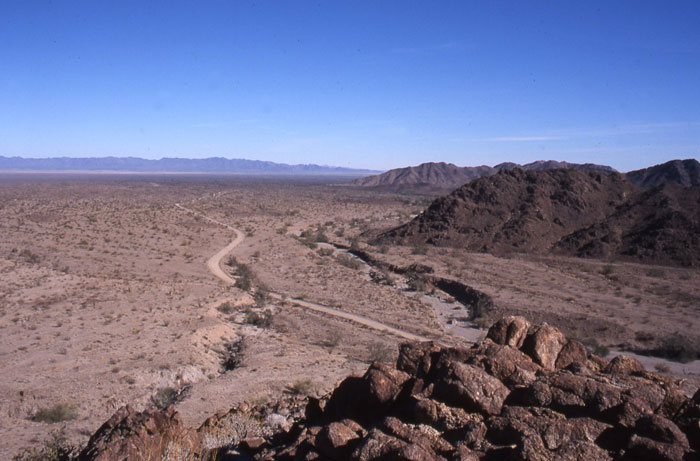
^Chuckwalla Valley view.
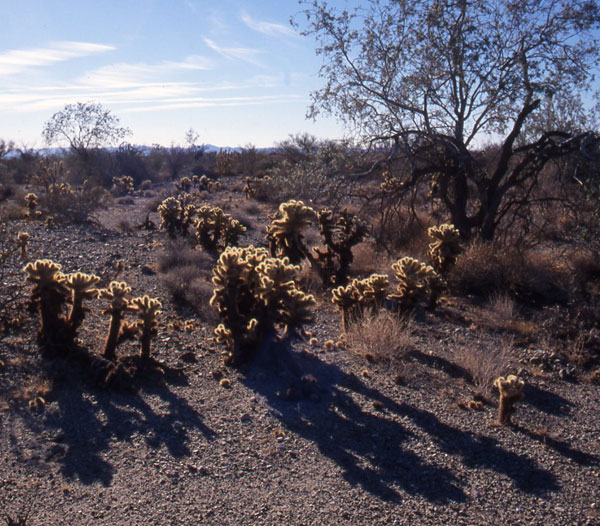
^Teddybear chollas and Ironwood, Chuckwalla Bench.
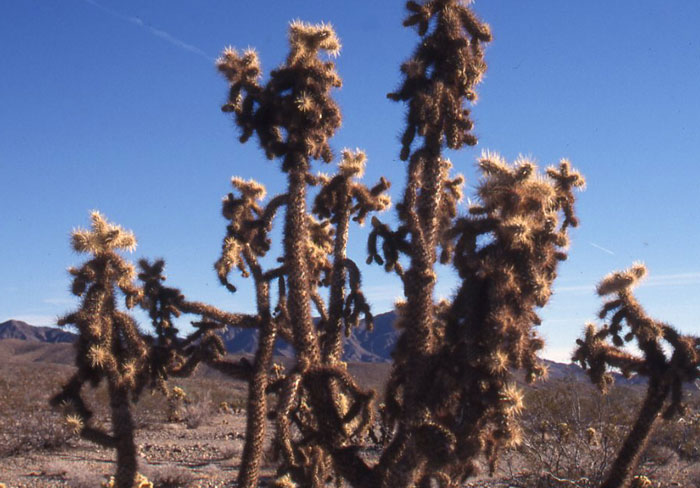
^Munz cholla.
